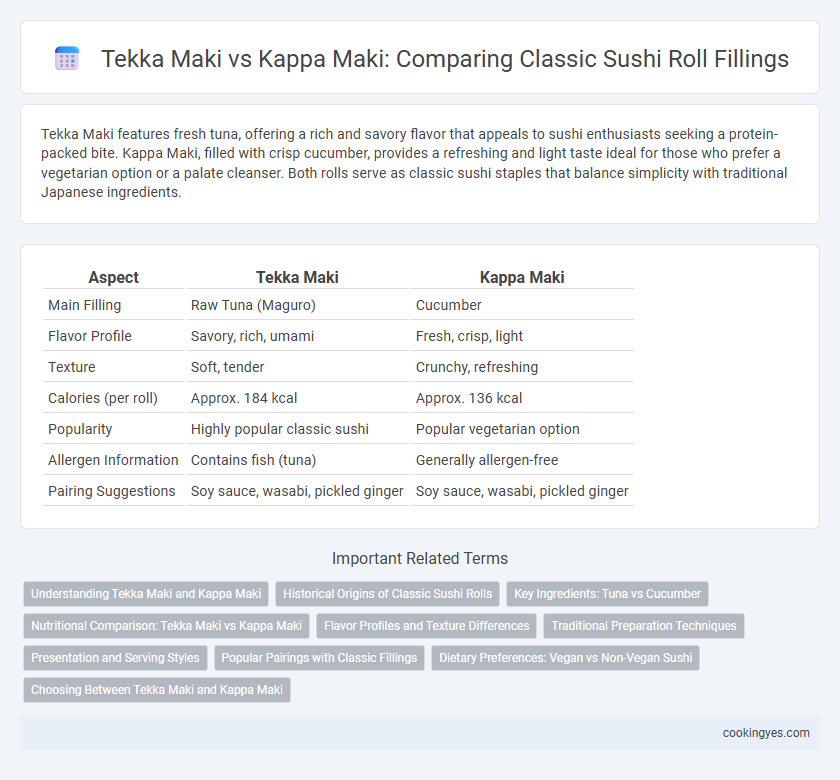Tekka Maki features fresh tuna, offering a rich and savory flavor that appeals to sushi enthusiasts seeking a protein-packed bite. Kappa Maki, filled with crisp cucumber, provides a refreshing and light taste ideal for those who prefer a vegetarian option or a palate cleanser. Both rolls serve as classic sushi staples that balance simplicity with traditional Japanese ingredients.
Table of Comparison
| Aspect | Tekka Maki | Kappa Maki |
|---|---|---|
| Main Filling | Raw Tuna (Maguro) | Cucumber |
| Flavor Profile | Savory, rich, umami | Fresh, crisp, light |
| Texture | Soft, tender | Crunchy, refreshing |
| Calories (per roll) | Approx. 184 kcal | Approx. 136 kcal |
| Popularity | Highly popular classic sushi | Popular vegetarian option |
| Allergen Information | Contains fish (tuna) | Generally allergen-free |
| Pairing Suggestions | Soy sauce, wasabi, pickled ginger | Soy sauce, wasabi, pickled ginger |
Understanding Tekka Maki and Kappa Maki
Tekka Maki features fresh tuna as its classic filling, delivering a rich, savory flavor with a firm texture that appeals to seafood enthusiasts. Kappa Maki uses crisp cucumber, offering a refreshing, crunchy bite with subtle vegetal notes, ideal for those seeking a lighter sushi option. Both rolls highlight simplicity and tradition, representing essential components of Japanese sushi cuisine through their distinct taste profiles and nutritional benefits.
Historical Origins of Classic Sushi Rolls
Tekka Maki, traditionally filled with raw tuna, traces its origins to Edo-period Japan where fresh fish became a staple in sushi. Kappa Maki, filled with crisp cucumber, reflects the use of local vegetables during times when fish was scarce or expensive, symbolizing frugality and seasonal availability. Both rolls represent key historical adaptations in classic sushi fillings, showcasing the evolution of sushi culture based on regional ingredients and economic factors.
Key Ingredients: Tuna vs Cucumber
Tekka Maki features fresh, high-quality tuna as its primary filling, offering a rich, umami flavor that sushi enthusiasts savor. Kappa Maki highlights crisp cucumber, delivering a light, refreshing crunch ideal for those seeking a vegetarian option. Both rolls use vinegared sushi rice and nori, but the choice between protein-rich tuna and hydrating cucumber defines their distinct taste profiles.
Nutritional Comparison: Tekka Maki vs Kappa Maki
Tekka Maki, made with tuna, offers higher protein content and essential omega-3 fatty acids compared to Kappa Maki, which features cucumber and provides more fiber and fewer calories. The iron and vitamin B12 levels in Tekka Maki support muscle function and energy metabolism, whereas Kappa Maki is richer in antioxidants and hydration benefits due to its cucumber filling. Choosing between these classic sushi rolls depends on whether you prioritize lean protein intake or low-calorie, plant-based nutrients.
Flavor Profiles and Texture Differences
Tekka Maki features raw tuna with a rich, meaty flavor and a tender texture that melts in the mouth, offering a bold and savory taste experience. Kappa Maki, filled with crisp cucumber, delivers a refreshing crunch and a light, slightly sweet flavor that contrasts with the softness of the rice and nori. The combination of these distinct texture profiles and flavor intensities makes Tekka Maki and Kappa Maki classic sushi options catering to different palate preferences.
Traditional Preparation Techniques
Tekka Maki features freshly sliced tuna wrapped in seasoned sushi rice and nori, showcasing the traditional method of selecting premium fish for optimal texture and flavor. Kappa Maki highlights the use of crisp cucumber, emphasizing precise julienne cutting and careful rice seasoning to balance freshness and acidity. Both rolls rely on the classic hand-rolling technique with bamboo mats, preserving authentic textures and proportions in each bite.
Presentation and Serving Styles
Tekka Maki, featuring vibrant red tuna wrapped in seaweed and sushi rice, offers a visually striking presentation with its rich color contrast and often served in neat, bite-sized slices. Kappa Maki, filled with crisp cucumber, presents a fresh green hue and a lighter appearance, typically arranged in simple, elegant rolls that emphasize its refreshing texture. Both rolls showcase traditional sushi techniques but differ in their visual appeal and serving styles, highlighting the balance between bold and subtle flavors.
Popular Pairings with Classic Fillings
Tekka Maki, featuring fresh tuna, pairs excellently with wasabi and soy sauce, enhancing its rich umami flavor, while Kappa Maki, filled with crisp cucumber, complements light pickled ginger and a dash of spicy mayo. Both sushi rolls are classic choices in Japanese cuisine, frequently served alongside miso soup and edamame to balance their refreshing textures. Popular pairings emphasize freshness and subtle seasoning, inviting a harmonious sushi experience.
Dietary Preferences: Vegan vs Non-Vegan Sushi
Tekka Maki features raw tuna, making it a popular choice for non-vegan sushi enthusiasts seeking classic fillings rich in protein and omega-3 fatty acids. Kappa Maki, filled with cucumber, offers a fresh, crunchy option that aligns perfectly with vegan and vegetarian dietary preferences, providing low-calorie nutrition and fiber. Both rolls serve distinct dietary needs, with Tekka Maki catering to seafood lovers and Kappa Maki supporting plant-based diets in traditional sushi cuisine.
Choosing Between Tekka Maki and Kappa Maki
Tekka Maki features fresh tuna as its classic filling, offering a rich, savory flavor ideal for seafood lovers seeking a protein-packed sushi option. Kappa Maki, filled with crisp cucumber, provides a refreshing, vegetarian-friendly alternative with a light, crunchy texture perfect for those preferring plant-based sushi. Choosing between Tekka Maki and Kappa Maki depends on dietary preferences and desired taste profiles, with Tekka delivering robust umami and Kappa emphasizing subtle freshness.
Tekka Maki vs Kappa Maki for Classic Fillings Infographic

 cookingyes.com
cookingyes.com